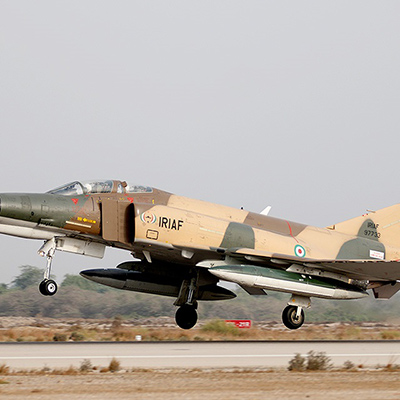Sites
Bandar Abbas 9th Air Base
Mohsen Shir-Muhammad
111 دورہ
The 9th Air Base is next to the city of Bandar Abbas, overlooking the Strait of Hormuz. Due to its strategic location, the base played a significant role during the Iran–Iraq War.
The history of the Bandar Abbas Air Base dates back to the 1960s. In 1963, an air station was opened in Bandar Abbas. Starting in 1969, the development of the airport and the construction of related facilities were completed by 1973.[1] By 1977,[2] the base became the final air force station to receive F-4 Phantom fighter-bombers, and thus the 9th Air Base was officially established in the city.[3]
In the early 1970s, given Iran’s extensive coastline along the Persian Gulf and the Gulf of Oman and the growing need for maritime patrols, six P-3F Orion aircraft were purchased. Initially intended for the Iranian Navy, the aircraft were instead delivered to the Air Force due to the lack of necessary infrastructure within the naval forces. In 1974, these planes were stationed at the Bandar Abbas Base.
Following the onset of the Dhofar conflict in Oman, known as the Dhofar War, the Sultan turned to Iran for military support. From 1972 to 1975, the Iranian Army helped Oman in suppressing the rebellion. Bandar Abbas Air Base played an active role in this operation, with F-4 Phantom jets conducting numerous sorties over southern Oman and the Dhofar region.[4]
After the 1979 Islamic Revolution, the P-3F aircraft were relocated from Bandar Abbas to Shiraz Air Base due to maintenance challenges.[5]
By 1980, on the eve of the Iran–Iraq War, Bandar Abbas Air Base was equipped with 26 F-4 fighter jets, 23 of which were fully operational. The base had 41 fighter pilots[6] and about 1000 technical and support personnel.[7]
Due to its distance from the Iraqi border, Bandar Abbas Air Base was not targeted in Iraq’s initial airstrikes. However, on the day following the Iraqi invasion, the Iranian Air Force launched a large-scale retaliatory operation known as Kaman 99, targeting major Iraqi military bases and facilities. In this operation, the 9th Air Base (Bandar Abbas) was assigned to support the Bushehr 6th Air Base and Hamedan 3rd Air Base, defend the airspace over the Persian Gulf and the Strait of Hormuz, and provide air cover for Iranian naval units.[8]
There were unconfirmed reports in the early days of the war suggesting that Iraqi Osa-class missile boats had been spotted near Abu Dhabi. If true, this would have placed Bandar Abbas at risk of a naval assault by Iraq. Thus, the Iranian Navy requested aerial reconnaissance. On October 2, 1980, an RF-4 aircraft was deployed to photograph the area in question. That same day, F-4 Phantom fighter jets at Bandar Abbas were armed with Maverick missiles and placed on alert, ready to engage the Iraqi vessels if confirmed. However, after the reconnaissance mission, it turned out that the reports were false.[9]
In October 1980, pilots from Bandar Abbas were deployed to the Shahid Nojeh Air Base in Hamedan to take part in combat missions against Iraqi forces.[10]
Meanwhile, as the Soviet Union had occupied Afghanistan to which the Afghan mujahideen put up resistance—with the US support they received through Pakistan—concerns arose about the possibility of the conflict spilling into Iranian territory. Therefore, Bandar Abbas Air Base was tasked with providing the necessary preparations for dealing with potential threats along the eastern borders. However, because of the base’s distance from the eastern frontier, two F-4 Phantoms were temporarily relocated to Chabahar Air Base to quickly counter any hostile moves.[11]
Throughout the Iran–Iraq War, and especially before the Tanker War reached its peak in 1987,[12] aircraft and pilots from the Bandar Abbas 9th Air Base were regularly dispatched to frontlines in Dezful, Hamedan, and Bushehr to participate in combat missions.[13] For example, in Operation Valfajr 8, the Bandar Abbas Base played a key role in replacing the destroyed aircraft.[14]
One of the most significant operations carried out by the 9th Air Base (Bandar Abbas) took place during the Tanker War. As Iraq began targeting Iranian oil tankers in the Persian Gulf, the Bandar Abbas Base was tasked with responding to these threats. Thus, two F-4 Phantom fighter jets were stationed on Kish Island to escort convoys of oil tankers and counter any Iraqi aerial attack.[15]
As support for Iraq from Gulf states such as Saudi Arabia and Kuwait intensified, Iran decided to retaliate by targeting oil and commercial vessels belonging to those countries.[16] Subsequently, F-4 Phantoms flew from Bandar Abbas and carried out multiple missions, striking ships belonging to these states. For instance, on April 17, 1986, a Saudi liquefied gas tanker near the country’s shores was targeted by the Maverick missile which F-4s of Bandar Abbas Base had fired.[17]
With the expanded US military presence in the Persian Gulf, limited confrontations also occurred between American forces and Iranian aircraft deployed from Bandar Abbas. For example, in 1984, an Iranian Phantom was hit by a US surface-to-air missile, but the pilots successfully managed to land the damaged aircraft back at Bandar Abbas.[18] Later, in 1988, F-14 fighter jets were also deployed to Bandar Abbas to enhance the base’s air combat capabilities.[19]
A tragic event also took place in 1988 within the airspace controlled by Bandar Abbas Air Base: the downing of Iran Air Flight 655 by missiles fired from the USS Vincennes, resulting in the martyrdom of 290 civilian passengers and crew on board.[20]
After the Iran–Iraq War, Bandar Abbas Air Base continued to safeguard Iranian airspace over the Persian Gulf, the Strait of Hormuz, and the Gulf of Oman. The base’s Phantoms regularly conduct reconnaissance missions over Iranian islands such as Abu Musa, Greater Tunb and Lesser Tunb. One of the base’s notable post-war missions was the interception of the aircraft carrying a terrorist named Abdolmalek Rigi, leading to his capture.[21]
Prominent commanders and pilots of the base during the war include Fereydoun Talebdoost, Ali-Akbar Eskandari, Fereydoun Samadi, and Qasem Mosaed.[22] The current commander of the Bandar Abbas 9th Air Base is Brigadier General Mohsen Heydarian.[23]
Following an air accident during a military exercise in the Persian Gulf on May 8, 1995, which led to the martyrdom of pilot Khosrow Abdolkarimi, the base was renamed Shahid Abdolkarimi Air Base in his honor.[24]
[1] Nosrati, Mehrdad, Parvaz bar Faraz-e Khalij-e Fars (Flying over the Persian Gulf), Saf Monthly, No. 440, Bahman 1396, p. 36.
[2] Ali-Askari, Zohreh, Parvaz ba Atash (Flight with Fire), Jannat-e Fakkeh, 1395, p. 145.
[3] Namaki-Araqi, Alireza & Digaran, Tarikh-e Nabardhaye Havaie – Amaliyat-e Kaman 99 Mosoom be 140 Farvandi va Enhedam-e Niroo-ye Havai-ye Doshman (History of Air Battles – Operation Kaman 99 Known as the 140-Aircraft Offensive and Destruction of Enemy Air Force), Vol. 3, Tehran, Markaze Entesharate Rahbordi-ye NAHAJA, 1396, Pp. 62–63.
[4] Shir-Muhammad, Mohsen, Cheshman-e Oqab (Eagle Eyes), Tehran, Markaze Entesharate Rahbordi-ye NAHAJA, 1396, p. 105.
[5] Shir-Muhammad, Mohsen, Pakbazan-e Arseh-ye Eshq (Devoted Ones in the Realm of Love), Sanaye Havaie Monthly, No. 315, Mordad–Mehr 1397, p. 28.
[6] Gorouh-e Moallefin-e Tarikh-e Defa Muqaddas-e Havaie, Tarikh-e Nabardhaye Havaie – Ta Aghaz-e Tahajom-e Sarasari-e Araq (History of Air Battles – Until the Beginning of Iraq’s Full-Scale Offensive), Vol. 1, Tehran, Markaze Entesharate Rahbordi-ye NAHAJA, p. 393.
[7] Ibid., Pp. 62–63.
[8] Ibid.
[9] Shir-Muhammad, Mohsen, Cheshman-e Oqab (Eagle Eyes), Pp. 149–150.
[10] Ali-Askari, Zohreh, Ibid., Pp. 211–212.
[11] Gholami, Barat-Ali, Padafand-e Havaie – Seir-e Tosee va Takamol (Air Defense – Evolution and Development), Vol. 1, Tehran, Iran-e Sabz, 1399, p. 154; Ali-Askari, Zohreh, Ibid., p. 399.
[12] Hameh Chiz Dar Mored-e Jang-e Naftkeshha (Everything about the Tanker War), Khabargozari Kharg, 20 Mehr 1398, https://www.khargnews.ir
[13] Namaki-Araqi, Alireza & Digaran, Ibid., p. 62–63.
[14] Namaki, Alireza, Niroo-ye Havaie dar Defa Muqaddas (The Air Force in the Sacred Defense), Tehran, Iran-e Sabz, 1389, Pp. 293–294.
[15] Ali-Askari, Zohreh, Ibid., p. 400.
[16] Cordesman, Anthony & Abraham Wagner, Darshaye Jang-e Modern – Jang-e Iran va Araq, Vol. 2 (Lessons of Modern War – The Iran–Iraq War), trans. Hussain Yekta, Tehran, Marz-o-Boom, 1390, p. 32.
[17] Ali-Askari, Zohreh, Ibid., p. 411.
[18] Nosrati, Mehrdad, Parvaz bar Faraz-e Khalij-e Fars (Flying over Persian Gulf), Saf Monthly, No. 440, Bahman 1396, p. 35; Cordesman & Wagner, Ibid., p. 564.
[19] Cordesman & Wagner, Ibid., p. 585.
[20] Ibid., p. 565.
[21] Nosrati, Mehrdad, Koochak-Tarin Tahdid-e Doshman ra Koobandeh-Tar Pasokh Khahim Dad (We Will Respond More Forcefully to even the Smallest Enemy Threat), Saf Monthly, No. 463, Esfand 1398, p. 21.
[22] Namaki-Araqi, Alireza & Digaran, Ibid., p. 62–63.
[23] Khabargozari Seda va Simai-e Jomhouri Eslami, 10 Tir 1400, https://www.iribnews.ir/fa/news/3152877
[24] Khabargozari Fars (Fars News Agency), 13 Esfand 1391, https://www.farsnews.ir/news/13911212001049; Shahid Khosro Abdolkarimi, https://www.golzar.info/37551





